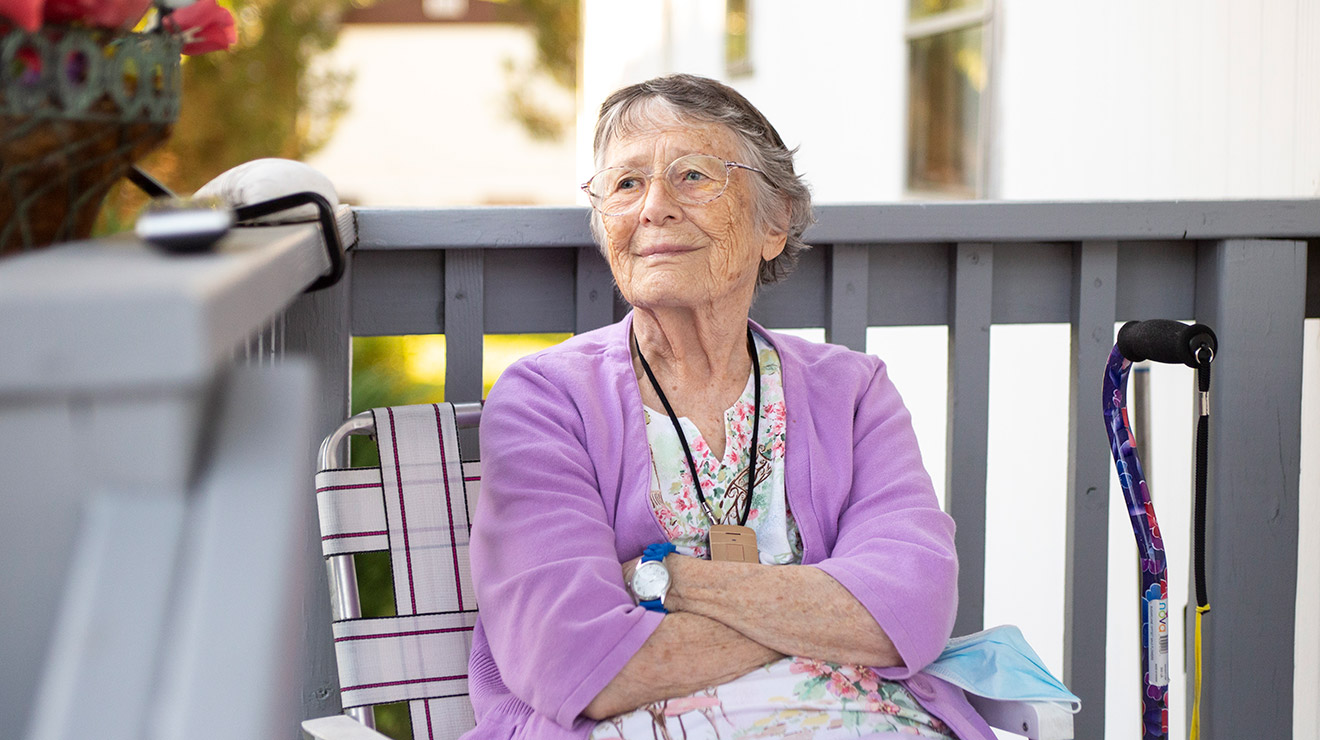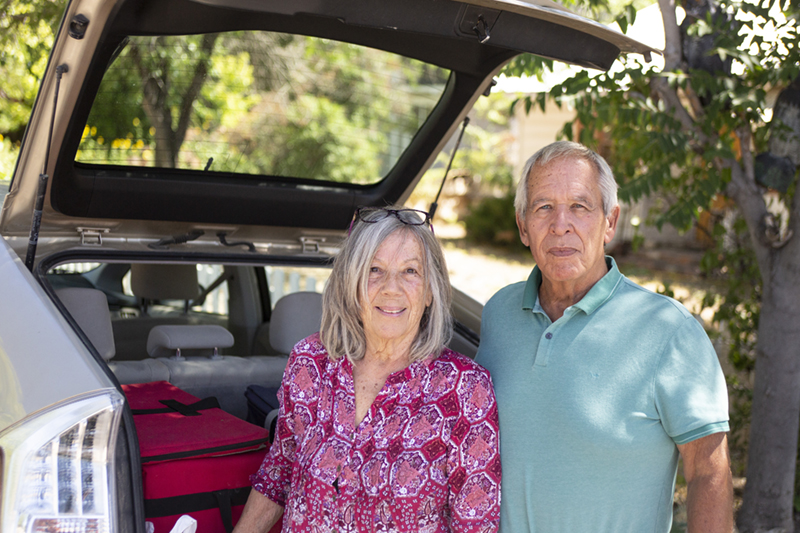
Rose Konola, outside her home in Clifton, Colo. on July 1, 2020. Photos by Luna Anna Archey
Rose Konola, outside her home in Clifton, Colo. on July 1, 2020. Photos by Luna Anna Archey
Ninety-year-old Rose Konola misses the conversations she used to have with Meals on Wheels volunteers who bring hot lunches to her home four days a week.
COVID-19 has changed the way the Mesa County chapter of the program provides meals to the elderly. While crucial to ensuring the safety of both clients and drivers, the necessary distancing precautions have been challenging for clients who rely on Meals on Wheels not just for nutritious meals, but the opportunity for interpersonal connection.
Konola, who resides in a mobile home in Clifton near Grand Junction, signed up for the program two years ago after cooking for herself became more difficult. She still keeps instant breakfast foods on hand, as well as TV dinners; occasionally, she mixes meat and veggies together for an easy crockpot meal.
Konola is a diabetic and two-time breast cancer survivor, and Meals on Wheels helps her to eat healthy and keep her diabetes in check, she said.
While the volunteer drivers never dally too long at any one home along their route—which typically takes nearly two hours to complete—pre-pandemic, volunteers would often linger to chat with clients who welcomed the company.
“I really enjoy the people from Meals on Wheels,” Konola said.
Volunteers would visit with Konola inside her home, where they’d talk about family, past camping trips and mutual health concerns. One of the drivers shares an interest in art with Konola, whose framed watercolor paintings of flowers—mostly roses—are displayed throughout her home.
“We had interesting conversations,” she said. “He bought two paintings from me.”
Before the pandemic, drivers were required to wait until someone answered the door or they weren’t allowed to leave the food. For the past three months, however, in response to COVID-19, the program has changed its practices to protect both customers and volunteers—many of whom are elderly themselves, and thus in the high-risk group for experiencing the most severe symptoms from the virus.
Home-delivered meals are now bagged and left on door handles for a contact-free delivery. Volunteers must wear masks and keep a distance.
“Sometimes I peek [out] at them and let them know I’m still here,” Konola said. “I miss them coming in; we’d visit.”
Konola’s husband passed away 10 years ago. Her daughter Claudette lives in Grand Junction and comes to visit every Wednesday. She takes her mother to medical appointments and picks up groceries for her. The two would often go out to eat before restaurants were shut down earlier this spring.
“I was getting bored sitting home for three months; then it warmed enough to sit on the porch,” Konola said. “Then the wind blew everything away and I couldn’t do that.” (Mesa County experienced extremely high winds for several days in June.)
Additionally, Konola is mourning the death of her cat Angel, who died this spring after 16 years of companionship. Konola kept Angel’s ashes, which she plans to bury next to her when the time comes.
In June, as businesses began reopening with some restrictions, Konola’s stylist offered to come to her home to trim her hair. “It had needed it for three months,” Konola said. “It was way down here,” motioning toward her shoulders.
“I told her I’d really like to go to the Dollar Tree store to pick out a birthday card for my sister. So, she drove me. We wore our masks. She got me a cart to hold onto [as a walker] and she sterilized it for me. Afterward, she sterilized my hands. Then she took me for a ride.
“That was my first outing.”
Another pair of eyes
There are 25 Meals on Wheels routes serving 400-plus residents throughout the Grand Valley, including in Clifton, Fruita, Grand Junction and Palisade. Additionally, more than 100 hot meals are served daily at each of several Meals on Wheels dining sites throughout the area, including in the towns of Collbran and Mesa. (Onsite dining has been canceled during the pandemic, although residents can pick up meals to-go.) Between the dining sites and deliveries, it amounts to more than 500 hot meals daily on average.
Lynne and Jonathan Parentice began volunteering as home delivery drivers three years ago, when the couple moved from Tucson to Grand Junction. Their granddaughter Allie is a Meals on Wheels volunteer and she urged her grandparents to get involved. The Parentices’ daughter Nicole has also been a volunteer. Great-granddaughter Elle has gone along with Lynne and Jonathan on their route at times.
“We’re a four-generation volunteering family,” Lynne said. “It’s wonderful for Elle to see what volunteering is all about.”

Lynne and Jonathan Parentice.
Volunteers converge at the Meals on Wheels kitchen and offices on Chipeta Avenue in Grand Junction by 10 a.m., Monday through Friday, to pick up their schedules and the prepared food. Just inside the door are cold and hot food containers packed with meals to be distributed that day.
Pre-pandemic, drivers often arrived a little early for a cup of coffee and perhaps a pastry, visiting with one another in the conference room before leaving on their individual routes. These days, any mingling takes place outdoors in the parking lot, at a distance, and with masks on.
While some of the volunteer drivers stopped due to fears of contracting the coronavirus, many more new people in the community have stepped up to volunteer—many of them because of newly available free time during the pandemic, according to Meals on Wheels staff. The program has even had to turn away interested helpers.
The volunteers serve as additional eyes on a population that is often frail, homebound and sometimes isolated. “Pre-coronavirus, we would wait until they come to the door,” said Lynne Parentice. “If they don’t come, we call them on the phone. We leave a note saying, ‘sorry we missed you, and we may order a wellness check if we don’t hear from you.’”
When the pandemic first hit Colorado, the Parentices, who are both 76, stopped driving for eight weeks. But with Mesa County’s confirmed COVID-19 cases remaining relatively low compared to surrounding communities, the couple have resumed their once-a-week route.
Jonathan walks the bagged meal up to the house, while Lynne, who does the driving, consults the schedule to check the next stop, making note of any special instructions. For example, a woman on their route leaves explicit instructions to slide the meal through the back window and onto a table. Jonathan said he’s seen her only once in two years.
While some clients are reclusive, others watch for the Parentices to arrive, opening the door when they see the couple pull up to the curb. Jonathan now keeps a distance as they exchange greetings.
“Some people like to socialize,” said Lynne Parentice. “For some, it’s their only social contact. These people rely on us. The meals are nutritionally balanced. People have gotten their diabetes under control, or lost weight.”
Jonathan now brings paperback books to one elderly couple after noticing what they like to read. He also carries dog biscuits for pets along the route. After telling a client that her car tires were overdue for a change, he noted two new tires the next time they delivered a meal to the house.

The Parentices prepare to make a meal delivery.
A “chance to chat”
During normal times, to qualify for Meals on Wheels home delivery, participants must be at least 60 years old and homebound. The homebound requirement has been waived for now, however, to include more at-risk individuals to protect them from unnecessary exposure to the coronavirus.
Some grant funders stipulate that Meals on Wheels give customers an opportunity to pay for the meals if they wish. The suggested donation per meal is $3.50.
“Customers can send any amount—$1, $5 or $5,000,” said Adrienne Carlo, Meals on Wheels program coordinator for home delivery meals in Mesa County. “It is completely optional. Sometimes a loved one asks for the form to be sent to them so they can pay for the meals.”
Typically, the program provides around 12,000 meals each month, via delivery or dining sites. In April, the number rose to more than 16,000, and remained nearly that high through May. Carlo attributes the increase in clients primarily to seniors wanting to avoid going to grocery stores during the pandemic.
Despite the increased demand, the program has continued to meet requests for home delivery—even though client contributions and corporate donations have decreased significantly during COVID-19. Regular donors previously included businesses that were shut down this spring, and organizations that have had fewer donations themselves to distribute.
At the same time, there has been an increase in contributions from local individuals, said Amanda Debock, the Meals on Wheels program manager. Plus, “we’ve applied for grants that have offset the drop, and so we’ve been able to pay for the increase we have seen.”
While the pandemic has forced Meals on Wheels to close its nine onsite dining halls, drive-through pickup options are taking place in some of those locations. Other sites continue to provide meals in other ways. For example, when onsite meals were discontinued at the Fruita Community Center, an employee began driving to Grand Junction to pick up the food, which she’d then deliver to those who used to come to Fruita’s dining hall. And in lieu of former dining sites at two Grand Junction senior living centers, residents instead come to the lobby to pick up meals to bring back to their individual apartments.
These closures, and the switch to to-go meals, does mean another opportunity for clients to socialize has disappeared for the time being.
Billie Jean and Chuck White, both 78, signed up for the home delivery program in early June after Chuck spent 42 days in the hospital due to heart failure. Billie Jean was unable to see her husband for much of that time due to coronavirus-related isolation policies.

Chuck and Billie Jean White.
After Chuck’s release from the hospital, physical therapists, speech therapists and occupational therapists were coming to the Whites’ home multiple times a day. Billie Jean said she didn’t have time to cook. She points to a calendar penciled in with multiple medical appointments every day: “So, we don’t have much free time. I’m not getting a lot done. I’ve been stressed out; I was worried sick.”
When they first applied for the home delivery program, there were no openings, so Billie Jean drove to the Meals on Wheels office to pick up the food to-go. Two weeks later, a slot opened up for home delivery. Billie Jean said she intended for the service to be temporary, but now she’s not sure. It will depend partly on how her husband’s health progresses, she said; plus, they like the meals and the volunteers.
While delivering meals is its number one mission, the ability of volunteers to check up on people is important, Carlo said. Since she began working for Meals on Wheels more than seven years ago, there have been four instances where her drivers have been first on the scene of an unattended death.
Even more important, she said, are the numerous occasions when volunteers have discovered a customer who has fallen and called 911. She remembers one man who was flat on his back and not in good shape when they found him. Although he passed away three days later, he didn’t die alone, she said.
“For many of our customers, we’re the main person they see that day,” Carlo said. “They have a chance to chat. I feel sad they’re missing that right now.”